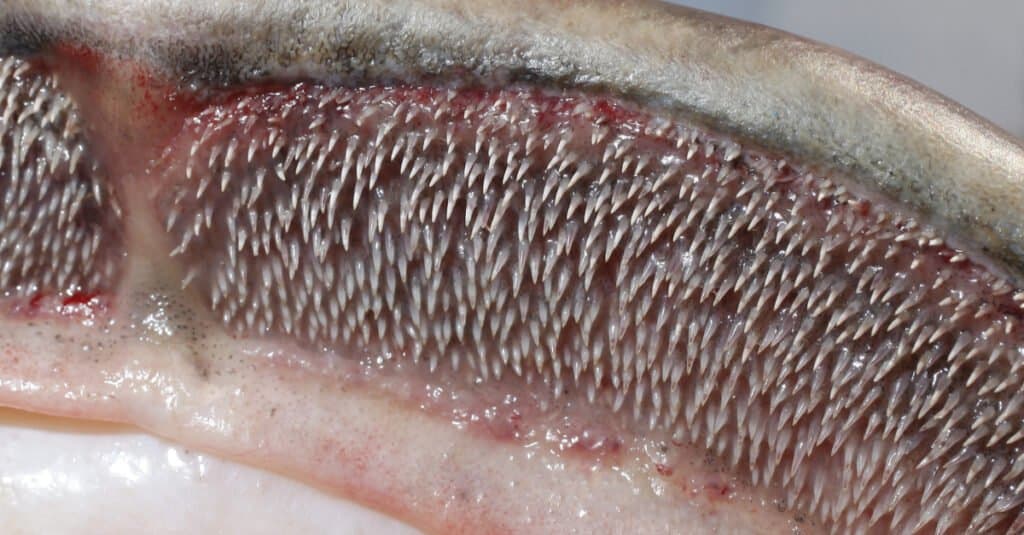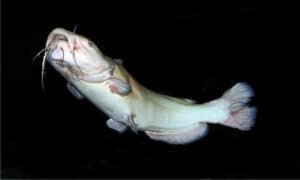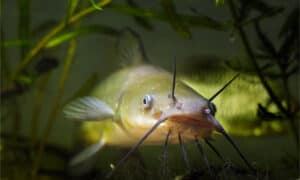Equipped with distinct whiskers on their faces and sensory receptors throughout their body, catfish are one of the most adaptable fish in the world. Catfish are able to thrive in environments which most marine animals are unable to. They eat an omnivorous diet that consists of snails, clams, aquatic insects, small fish, and other small sea creatures, who, like them, inhabit streams, ponds, rivers, and reservoirs.
Catfish lack the scales that ordinary fish have, and possess barbels on their faces instead, which let them taste, smell, and forage for food even when there is little to no visibility in the water. A catfish head also looks a little odd compared to regular fish. If you’ve ever captured one and looked into its mouth, you might be startled to see that it looks quite empty, and judging by what you see, you might initially assume that it doesn’t have any teeth. So, do catfish have teeth?
Do Catfish Have Teeth?

Catfish have small and dense teeth called cardiform.
©iStock.com/v_zaitsev
Yes, catfish have some form of teeth, but not in the traditional sense or anything you might be thinking of. Unlike most predators who have sharp incisors and large teeth, catfish teeth are small and dense, and are called cardiform. Hundreds of cardiform teeth are found in their mouths. Catfish mouths usually have a coarse sandpaper texture due to these minuscule cardiform teeth.
The conventional method of juvenile catfish feeding is sucking up algae and plant materials and then consuming them. Catfish species that are bigger, such as flathead catfish, will suction small fish such as minnows and crush them. These cardiform teeth are found in all catfish species.
How Do Catfish Teeth Work?
Cardiform teeth help catfish grind their food down. Since catfish are usually found inhabiting muds, they only eat crayfish, frogs, and other not so meaty animals, so there is no need for them to have incisors and molars.
When it comes to large predators, a row of teeth usually runs down the front and side of their jaw. They use these teeth to bite and cut into flesh. A catfish, on the other hand, will consume the majority of its prey whole, and hence has no need to chop it up before swallowing it. They have a large number of small teeth, which they use to grab things. The main purpose of these cardiform teeth is to make the food easier to swallow by helping them control and turn it, so that the prey is facing lengthways.
What Do Catfish Teeth Look Like?

Catfish have teeth that are incredibly tiny and dense.
©iStock.com/Renars2014
The catfish’s cardiform teeth are like incredibly short strands on a bristle brush. The catfish’s mouth and throat are lined with bristle-like sharp points. Their teeth are curved inwards to help them keep prey in their jaws.
You’re wrong if you think they have enormous, strong teeth because they are omnivores and can consume a wide variety of foods. Catfish suck and gulp rather than bite when they eat. Their teeth are extremely tiny and dense, and are as rough as sandpaper. They also tend to point inwards instead of out. So when feasting on their food, catfish use their unique set of teeth to keep their prey from escaping from their mouth’s grip. As they are slanted inwards, it makes it easier for victims to get into a catfish mouth but difficult to get out.
How Many Teeth Do Catfish Have?
In the back of their mouth, catfish have rows of teeth. The exact number of catfish teeth can still vary based on the type of catfish. There are about 3,000 species of catfish in the world, so be sure to keep in mind that this generally applies to all of them. The Goonch catfish, for instance, has four rows of teeth that contain hundreds. Some species can have lesser teeth.
How Do Catfish Eat Their Food?
As omnivores who prefer to eat by sucking and swallowing rather than chewing, catfish do not use their teeth to catch prey. This is where the misconception that they have no teeth originates. Catfish typically suck in their prey with a sucking motion before gulping it down. Because of this, many people believe that they don’t have any teeth.
Are Catfish Teeth Sharp?

Catfish have hundreds of small teeth in their mouth
©Richard Peterson/Shutterstock.com
Catfish teeth may not be essential for capturing prey, but that does not imply that they are boring and useless. The rows of teeth some catfish have inside their mouths are sharp and can easily hurt prey or even humans who are noodling for them.
These dull teeth, however light they can be, can still hurt you if you are noodling. Noodling is a different story than accidentally having your skin grazed when unhooking a catfish. Catfish can clamp down their teeth when noodling in an effort to escape. Goonch catfish, for example, possess razor-sharp teeth that may easily pierce the skin, making them a dangerous predator. Still, the sharpness of teeth varies depending on the species.
Can Catfish Bite?
Anatomically, catfish can’t bite because their teeth aren’t built for that. This is because their teeth are crooked, making it hard for them to bite someone. Their teeth are small and generally harmless. However, if a catfish were to bite you for some reason, there is a good chance that it won’t hurt your skin, and it won’t cause any serious injuries either.
They do not have canine or incisor teeth. This means that a catfish bite is just more likely to make the hand or fingers feel like they are being pressed against. You are very unlikely to have your skin broken by a catfish bite, but it could leave a coarse, scraped spot on your skin. If this happens, all you have to do is clean the scratch and cover it. It will soon start to heal on its own.
The photo featured at the top of this post is © iStock.com/v_zaitsev
Thank you for reading! Have some feedback for us? Contact the AZ Animals editorial team.






